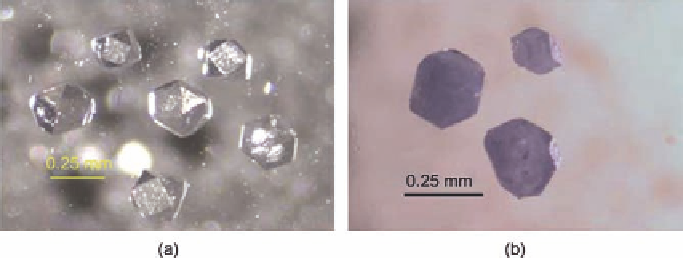Geoscience Reference
In-Depth Information
of HfO
2
(
Figure 9.16
) were obtained. Recently, Mann and Kolis
[90]
have obtained
single crystals of HfO
2
stabilized with yttrium, neodymium, holmium, and erbium
up to the size range of 0.25 mm from hydrothermal solutions by spontaneous nucle-
ation in 20 M KOH at 750
C. Single crystals of HfO
2
form only with high con-
centrations of the stabilizer dopants. As per the literature survey, this is the lowest
temperature hydrothermal synthesis of hafnia.
Figure 9.17a and b
shows the yttrium-
stabilized cubic hafnia crystals and neodymium-stabilized cubic hafnia crystals
[90]
. However, in recent years, the solvothermal synthesis of small nanoparticles of
zirconia and hafnia is very popular under much lower temperatures.
TeO
2
Tellurium dioxide has two modifications: tetragonal (paratellurite) and orthorhom-
bic (tellurite)
[91,92]
. Among these two, the paratellurite is of great interest for
solid-state physicists, because of its valuable piezoelectric and acousto-optical
properties. In particular, paratellurite crystals may be used in acousto-optical modu-
lators of light deflectors and delay lines. At present, there are several methods of
growing these crystals. The most popular is the Czochralski method but, in this
method, the growth temperature is high and there are strong temperature gradients
in the growth region
[93]
. This, together with the high vapor pressure of tellurium
dioxide, often results in the production of defected and stressed crystals. In addi-
tion, the method is rather cumbersome and only about 20% of crystals produced
have acceptable quality.
The hydrothermal method of crystallization of paratellurite started almost at the
same time as the Czochralski method
[91,92]
. However, the effects of various physi-
cal and chemical parameters on the growth of paratellurite crystals were not properly
studied. This technology is not advantageous because of its poor reproducibility and
the poor quality of crystals. The possibility of obtaining spontaneous paratellurite
monocrystals from solutions of hydrohalogenic acids was demonstrated in Ref.
[71]
.
It was found that the mass crystallization decreases in the following sequence:
HCl
HBr
HI
HF, while all other parameters are the same.
.
.
.
Figure 9.17 (a) Y
3
1
-stabilized and (b) Nd
3
1
-stabilized cubic HfO
2
crystals
[90]
.


